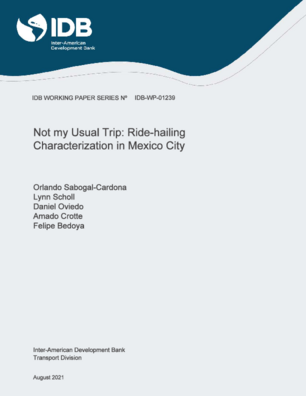Not My Usual Trip: Ride-hailing Characterization in Mexico City
Date
Aug 2021
With a few exceptions, research on ride-hailing has focused on North American cities. Previous studies have identified the characteristics and preferences of ride-hailing adopters in a handful of cities. However, given their marked geographical focus, the relevance and applicability of such work to the practice of transport planning and regulation in cities in the Global South is minimal. In developing cities, the entrance of new transport services follows very different trajectories to those in North America and Europe, facing additional social, economic, and cultural challenges, and involving different strategies. Moreover, the determinants of mode choice might be mediated by social issues such as the perception of crime and the risk of sexual harassment in public transportation, which is often experienced by women in large cities such as Mexico.
This paper examines ride-hailing in the Metropolitan Area of Mexico City, unpacking the characteristics of its users, the ways they differ from users of other transport modes, and the implications for urban mobility. Building on the household travel survey from 2017, our analytical approach is based on a set of categorical models. Findings suggest that gender, age, education, and being more mobile are determinants of ride-hailing adoption. The analysis shows that ride-hailing is used for occasional trips, and it is usually done for leisure and health trips as well as for night trips. The study also reflects on ride-hailings implications for the way women access the city.
This paper examines ride-hailing in the Metropolitan Area of Mexico City, unpacking the characteristics of its users, the ways they differ from users of other transport modes, and the implications for urban mobility. Building on the household travel survey from 2017, our analytical approach is based on a set of categorical models. Findings suggest that gender, age, education, and being more mobile are determinants of ride-hailing adoption. The analysis shows that ride-hailing is used for occasional trips, and it is usually done for leisure and health trips as well as for night trips. The study also reflects on ride-hailings implications for the way women access the city.




